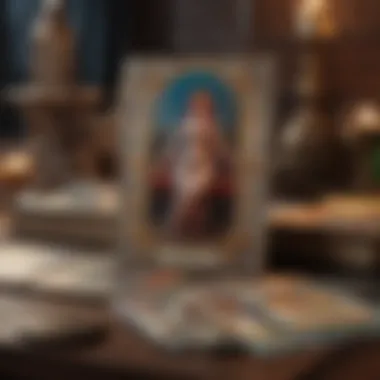Understanding the Third Party Relationship Tarot Spread


Intro
The Third Party Relationship Tarot Spread offers a unique lens through which to examine interpersonal dynamics. It focuses on the complexities that arise when a third party influences a primary relationship. Understanding this spread helps users gain insights into their connections, emotions, and the various elements at play. It serves as a guide to navigate relationship challenges and enhances personal growth.
Characteristics of Each Zodiac Sign
When exploring relationships in tarot, understanding the zodiac signs involved can enhance interpretation. Each sign carries distinct personality traits that influence interactions and relationships. Consider the following aspects:
Overview of Personality Traits
- Aries: Assertive and adventurous, often seeks independence.
- Taurus: Grounded and reliable, values stability and comfort.
- Gemini: Communicative and adaptable, enjoys social connections.
- Cancer: Nurturing and intuitive, holds deep emotional ties.
- Leo: Charismatic and creative, thrives on admiration.
- Virgo: Detail-oriented and analytical, tends to worry about perfection.
- Libra: Diplomatic and harmonious, seeks balance in relationships.
- Scorpio: Intense and passionate, deeply values loyalty.
- Sagittarius: Free-spirited and philosophical, craves adventure.
- Capricorn: Disciplined and ambitious, prioritizes responsibility.
- Aquarius: Innovative and unconventional, values personal freedom.
- Pisces: Compassionate and imaginative, often dreamy.
Strengths and Weaknesses
- Aries: Strengths: Courageous. Weaknesses: Impulsive.
- Taurus: Strengths: Dependable. Weaknesses: Stubborn.
- Gemini: Strengths: Versatile. Weaknesses: Indecisive.
- Cancer: Strengths: Empathetic. Weaknesses: Overly sensitive.
- Leo: Strengths: Confident. Weaknesses: Arrogant.
- Virgo: Strengths: Organized. Weaknesses: Overcritical.
- Libra: Strengths: Fair-minded. Weaknesses: Avoidant.
- Scorpio: Strengths: Resourceful. Weaknesses: Jealous.
- Sagittarius: Strengths: Open-minded. Weaknesses: Blunt.
- Capricorn: Strengths: Prudent. Weaknesses: Pessimistic.
- Aquarius: Strengths: Original. Weaknesses: Detached.
- Pisces: Strengths: Artistic. Weaknesses: Escapist.
Compatibility with Other Signs
Compatibility in a relationship can vary based on the zodiac signs involved. For example, Fire signs like Aries, Leo, and Sagittarius often find common ground due to shared enthusiasm. Earth signs such as Taurus, Virgo, and Capricorn can create stable partnerships through mutual understanding. Water signs, including Cancer, Scorpio, and Pisces, often connect through emotional depth, while Air signs—Gemini, Libra, and Aquarius—appreciate intellectual exchanges.
How to Interpret Tarot Cards
In the context of the Third Party Relationship Tarot Spread, card interpretation is crucial. This spread typically consists of several positions, each representing different aspects of the relationship. Understanding both the Major Arcana and Minor Arcana helps in providing clarity.
Major and Minor Arcana
- Major Arcana: Represents significant life lessons and archetypal themes.
- Minor Arcana: Focuses on everyday events and specific circumstances.
Meaning of Key Cards
Each card has specific meanings that can shift based on their position in the spread. For instance, The Lovers card signifies unity but in the context of a third party could imply choices that need to be made.
Sample Interpretations in Different Spreads
The meanings of the cards may change when utilized in different spreads. Adjusting the layouts can provide diverse insights into relationship dynamics.
Overview of Deck Styles
Different tarot decks offer various artistic expressions and interpretations. Popular decks like The Rider-Waite-Smith, The Tarot of Marseille, and The Thoth Tarot each bring unique perspectives to readings that can enrich one's understanding.
Popular Decks and Their Unique Features
- Rider-Waite-Smith: Known for its detailed imagery, making it beginner-friendly.
- Tarot of Marseille: Features simplified imagery that focuses on symbolism.
- Thoth Tarot: Incorporates astrological and Kabbalistic elements that appeal to deeper study.
Synthesis
The exploration of the Third Party Relationship Tarot Spread unveils complex interpersonal nuances. Utilizing comprehensive card meanings and understanding zodiac influences allows for greater insights in readings. Emphasis on context and interpretation will aid both novice and experienced readers in leveraging this tool for personal development or professional practice. The art of tarot reading occurs through a harmonious blend of card interpretation and personal intuition.
Preface to Tarot
A flexible framework, tarot can offer guidance in various life situations, whether personal or professional. By learning about tarot history and structures, readers can appreciate the art of interpreting the cards more effectively. Those who seek to understand the nuances behind each spread can gain from the enriched perspectives it can offer in relationships, particularly when involving a third party.
The upcoming sections will delve into the rich history of tarot along with a clearer understanding of the different types of tarot decks. Both elements are essential for anyone wishing to navigate the complexities of the third party relationship tarot spread.
History of Tarot
The origins of tarot are both fascinating and obscure. Dating back to the late 14th century, tarot cards began as a simple card game in Europe, particularly in Italy. The tarot evolved from these games into a mystical tool by the late 18th century. This transformation was influenced by various esoteric traditions and philosophies, which shaped the way tarot is viewed today.
Key points about the history of tarot:
- Initial Use: Tarot served primarily as a game before it adopted esoteric and spiritual significance.
- Cultural Influence: Various cultures contributed to the evolution of tarot, including Islamic and Jewish mystical traditions, leading to different interpretations and decks.
- Symbolism Growth: The imagery on tarot cards morphed over time, integrating rich symbolism that speaks to the human experience.
"The history of tarot is a journey through cultural evolution and spiritual exploration. Understanding this evolution deepens one's connection to the cards."
Understanding this history is paramount as it informs the symbolism and meanings that card readers exploit in their readings today.
Understanding Tarot Decks
A key aspect of tarot is the variety of decks available. Each deck holds its own unique imagery, themes, and interpretations. Knowing the choice of deck will impact reading experiences. For example, the Rider-Waite-Smith Tarot is among the most widely used and features particular imagery that resonates with many querents. In contrast, decks like the Thoth Tarot or Marseille Tarot present differing interpretations based on their historical and artistic roots.
When choosing a deck, consider the following factors:


- Artistic Style: Personal preference for the art can influence one's connection to the cards.
- Card Meanings: Familiarity with the deck's symbols and meanings is essential for effective reading.
- Reader’s Intuition: Ultimately, intuition plays a significant role in selecting a deck that feels right for the reader.
In summary, understanding the various tarot decks is not just a matter of preference; it is fundamental to developing an insightful practice, especially when using specific spreads like the third party relationship tarot spread.
The Purpose of Tarot Spreads
Tarot spreads serve as structured frameworks that help focus a reading. Their primary purpose includes providing clarity and depth to inquiries related to life, relationships, and personal challenges. When readers apply the right spread for their questions, they can uncover layers of meaning that may remain hidden when using only individual cards. The beauty of tarot lies in its ability to provide insight into complex situations, and well-developed spreads assist in this process.
Each type of spread offers varied benefits. For instance, some spreads are designed to assess one's past, present, and future, while others might allow for a more nuanced exploration of relationships, such as the third party relationship spread. As a reader, understanding the purpose of each spread is crucial. It can mean the difference between vague responses and meaningful revelations.
Types of Tarot Spreads
There are numerous types of tarot spreads, each tailored to different themes or queries. Here are a few common ones:
- Single Card Spread: Simple and straightforward, great for quick insights.
- Three Card Spread: Often used for past, present, and future analysis.
- Celtic Cross Spread: A more detailed spread that covers multiple aspects of a situation.
- Relationship Spread: Focus on the dynamics between two or more people.
- Third Party Relationship Spread: Specifically created to analyze the influence of an external party in relationships.
By knowing the different spreads, readers can choose one that aligns most closely with their needs, facilitating a more effective reading.
Function of the Third Party Spread
The third party relationship spread is designed to unravel the complexities that arise when an external influence is present in a relationship. This external influence may be a person or situation that complicates, supports, or challenges the primary relationship.
This spread allows readers to see the nuances of how the third party affects two individuals involved. It sheds light on the dynamics at play, revealing insights that may not be visible from an internal standpoint. Understanding this function is vital, especially since relationships are rarely isolated from external influences.
- Clarity: It provides insight on how external factors impact personal dynamics.
- Perspective: Offers both parties a chance to view their situation through different lenses, enhancing empathy.
- Resolution: By understanding the role of the third party, individuals can make informed decisions regarding their relationship.
What is a Third Party Relationship Tarot Spread?
The Third Party Relationship Tarot Spread is a unique tool designed to explore the dynamics involved in relationships with an external influence or party. This spread is significant for users seeking to grasp the complexities surrounding interpersonal connections that involve more than just two individuals. The insights gained from this spread can reveal hidden motives, suggest potential outcomes, or illuminate how a third party impacts the relationship in question.
Definition and Significance
Defining the Third Party Relationship Tarot Spread requires recognizing its goal of shedding light on interactions that go beyond direct relationships. Engaging with this specific spread allows users to dissect the role and influence of a third entity in dynamics they are experiencing. It helps identify areas of conflict, tension, or support that may stem from this external party. The significance lies in its application, providing clarity in challenging situations that might otherwise remain murky.
- Clarification: By uncovering the influence and intentions of a third party, this spread aids in understanding the motivations at play.
- Navigational Aid: It supports better decision-making by highlighting how the presence of a third party complicates or enriches a relationship.
- Personal Insight: Users gain deeper self-awareness regarding their feelings and reactions to the dynamics at play.
In essence, understanding what a Third Party Relationship Tarot Spread entails is crucial for meaningful interpretation. It serves a pivotal role for both the client and the reader, leading to constructive dialogue and reflection on relational matters.
Common Scenarios for Use
The Third Party Relationship Tarot Spread can be utilized in various scenarios, making it a versatile asset for tarot readers.
- Romantic Relationships: When exploring love triangles or external romantic interests, this spread reveals how a third party influences the bond between partners.
- Friendships: In cases where a friend feels overshadowed or influenced by another mutual friend, the spread can clarify underlying tensions or challenges.
- Workplace Dynamics: It can examine how a coworker or manager affects workplace relationships and team dynamics.
- Family Matters: When family disputes arise involving in-laws or friends, this spread aids in uncovering deeper issues.
Employing this spread in these scenarios offers a targeted approach to understanding the multilayered intricacies inherent in relationships. As readers become adept at interpreting the cards within this context, their ability to provide meaningful insights flourishes, benefitting both themselves and their clients.
Structure of the Spread
Understanding the structure of the Third Party Relationship Tarot Spread is crucial for gaining insight into interpersonal dynamics. This spread's layout helps to organize the reading, allowing the reader to delve into the complexities of relationships involving a third party. Each card's position is selected with intent, guiding an interpretation that reveals both overt signals and hidden messages.
The benefits of this structured approach cannot be overstated. First, a clear structure facilitates focused analysis. Each card represents a distinct element of the relationship, creating a coherent narrative. Second, it aids in uncovering layers beneath the surface. Relationships are rarely straightforward, and a structured spread illuminates various facets of interaction, including motivations, conflicts, and resolutions. Furthermore, by adhering to this structure, readers can approach the cards with a systematic mindset, reducing the potential for chaotic interpretation.
Typical Card Positioning
In the Third Party Relationship Tarot Spread, card positioning follows a specific framework that reflects different aspects of the relationship with a third party. Commonly, practitioners use a five or seven-card layout. Each position has a particular significance.
- Position One: Represents the querent's view of the situation. This sets the stage for understanding their perspective.
- Position Two: Reflects the third party's influence. This highlights how this person impacts the relationship dynamics at play.
- Position Three: Indicates the partner's stance. It helps to reveal their role and feelings within the context.
- Position Four: Addresses the core issues or conflicts present. Here, tension points are revealed, paving the way for resolution insights.
- Position Five: Offers potential outcomes, indicating where the relationship may head based on current dynamics.
This method of card positioning ensures a step-by-step analysis, allowing readers to reflect deeply on each card's input toward a complete understanding of the interpersonal scenario.
Understanding Each Position
Each position in this spread carries specific meanings, making comprehension vital for accurate interpretation. Readers should consider not only the individual card meanings but also their context within the spread.
- First Position Meaning: This card typically showcases the querent's beliefs and emotional state. It serves as a mirror, reflecting attitudes that may influence their choices.
- Second Position Interpretation: The third party card can reveal how this individual is perceived. It could signal friendship, competition, or conflict. Each interpretation will guide the reader toward understanding the third party's role.
- Third Position Analysis: The partner's card often unveils feelings and intentions. It highlights where they stand and their emotional availability regarding the relationship.
- Fourth Position Insights: The issues card indicates the root problems that need to be addressed. It underscores the hurdles the relationship must navigate to achieve harmony.
- Fifth Position Outcome: This card functions as predictive insight. It can suggest where the energy of the relationship may flow, emphasizing outcomes contingent on current states and actions.
A careful examination of each position equips readers with a more expansive understanding. This insight becomes indispensable for navigating the intricate landscape of relationships, especially those involving third parties.
Interpreting the Cards
In tarot, interpreting the cards is a fundamental aspect that requires both intuition and knowledge. For the Third Party Relationship Tarot Spread, understanding how to interpret each card can unveil layers of interpersonal dynamics that may not be immediately clear. This section will guide the reader in navigating these interpretations, focusing on specific elements like context, card positions, and emotional nuances.
Interpreting involves analyzing not just the card meanings but also their positions within the spread. Each position is symbolic and relates to different aspects of the situation at hand. For example, a card in the position signifying the third party may highlight external influences that impact the primary relationship. It is crucial to observe how these cards interplay, as they collectively tell a nuanced narrative.


Benefits of Proper Interpretation
Understanding how to interpret the cards brings several advantages. It enables the tarot reader to:
- Gain insights into motivations behind actions.
- Identify areas of conflict or miscommunication.
- Foster deeper relationships by illuminating dynamics that are often overlooked.
Moreover, enhancing one's skills in interpretation can lead to more meaningful readings, whether personally or professionally.
Key Card Meanings
In the context of the Third Party Relationship Tarot Spread, several cards take on particular significance. Here are some commonly encountered cards and their implications:
- The Lovers
- The Devil
- Three of Cups
- The Tower
- Two of Swords
- This card often represents harmony, but in a third-party spread, it can indicate choices or conflicts within relationships.
- It suggests manipulation or obsession. Its presence may highlight negative influences or toxic dynamics involving the third party.
- This card typically signifies friendship and celebration, but it can also point to infidelity or a love triangle.
- An indication of sudden change or upheaval. It raises awareness of emerging truths that could disrupt a stagnant situation.
- This card indicates a stalemate or indecision. It can show the blockage caused by the presence of a third party, preventing necessary actions from being taken.
These card meanings can shift based on their placement and surrounding cards, making the context critical.
Reversed Card Implications
Reversed cards add another layer of depth to interpretations. They often symbolize blockages, delays, or states of resistance.
- The Lovers (Reversed)
- The Devil (Reversed)
- Three of Cups (Reversed)
- The Tower (Reversed)
- Two of Swords (Reversed)
- It can manifest as disharmony or imbalance, suggesting that decisions made may be driven by fear rather than love.
- This could symbolize liberation from constraints related to the third party, indicating a potential emotional break.
- It may suggest isolation or the dissolution of a relationship originally believed to be strong. It highlights deceptive friendships.
- It can indicate resisting change, pointing to the unwillingness to face truths about the third party's influence.
- It signals a shift, suggesting that the querent is finally ready to make difficult decisions regarding the relationship dynamic.
Understanding the nuances of reversed cards is essential for a comprehensive reading. They often bring forward unseen conflicts that may need resolution.
"The key to unlocking the mysteries of tarot lies in focusing on both the individual meanings and their interrelations within the spread."
Influence of the Third Party
Understanding the influence of the third party in relationship tarot readings is crucial. This spread, distinct from others, often highlights external factors that shape personal relationships. The third party might be a person, a situation, or even an influence that does not belong to the primary dynamics between the querent and their partner. Recognizing this element is vital for gaining a complete picture of interpersonal dynamics.
Role of the Third Party in Readings
The role of the third party in readings can vary widely. They might be a friend, family member, or someone entirely outside of the immediate relationship. This influence can introduce conflict or provide insight, depending on the nature of their involvement. For instance, if the third party is a supportive friend, their role might be to offer guidance. Conversely, if they are seen as an antagonist, their influence may foment tension and confusion.
Tarot readers should focus on specific card positions that elucidate the role of this third party. For example, cards like The Tower may indicate disruptive influences, while The Empress often signifies nurturing support. By interpreting these variations, readers can pinpoint how the third party impacts the querent’s feelings or decisions.
Navigating Complicated Dynamics
Navigating the dynamics that a third party brings requires careful thought. When readings reveal complications due to external influences, it is vital to approach interpretations with a balanced perspective. The goal here is to understand not only the third party's influence but also how it reflects on the querent's state of mind and relationships.
Consider the context of the reading. If a querent is feeling threatened by a third party, this may indicate an area of insecurity. In contrast, a feeling of support from a third party often represents a vibrant community around a relationship.
The third party can dramatically change one’s emotional landscape, making it essential to examine these energies closely.
Practical methods for managing these readings include:
- Clarifying Questions: Asking deeper questions about the third party's impact can unearth surprising insights.
- Mindfulness: Staying objective during the reading helps prevent personal biases from affecting interpretations.
- Visualization: Encourage clients to visualize the third party, aiding in understanding the emotional context of their involvement.
By utilizing these techniques, tarot readers can harness the complexities of third parties, transforming potential misunderstandings into opportunities for growth and clarity.
Practical Applications
Understanding the practical applications of the Third Party Relationship Tarot Spread is essential for those seeking clarity in interpersonal dynamics. This spread serves not only as a tool for divination but also as an instrument for deeper self-awareness and interpersonal understanding. With its unique design tailored to illuminate the complexities of third-party relationships, it can guide users through various scenarios and dilemmas that often arise in relational contexts.
Utilizing this spread effectively can yield insights that are both profound and actionable. By engaging with the cards, individuals can glean perspectives that help in navigating potential conflicts or misunderstandings. This method encourages introspection, prompting users to confront their emotions and thoughts regarding the third party involved.


Using the Spread for Self-Reflection
When applying the Third Party Relationship Tarot Spread for self-reflection, the goal is to promote awareness of one's own feelings and motivations. This often requires setting a clear intention before laying down the cards. For instance, a practitioner may ask themselves: "What role does the third party play in my life?" or "How does my perception of this individual affect my relationships?"
The layout of the spread can reveal illuminating insights about personal insecurities or biases. Each card drawn will reflect aspects of the querent's emotional state or behavior concerning the third party, potentially leading to realizations about one's own patterns. Here are practical steps to consider:
- Set an intention: Define what you want to learn from the spread.
- Record your feelings: Write down initial thoughts before beginning.
- Review the cards: Examine each one in relation to your question, focusing on both their upright and reversed meanings.
- Journal about insights: Reflect on what the cards reveal about your feelings and assumptions.
These steps create a structured approach to self-reflection, guiding one through personal complexities that may have otherwise remained unexamined.
Incorporating into Professional Readings
The Third Party Relationship Tarot Spread also holds significant value in professional readings, offering practitioners a structured way to address client concerns involving outside influences in their relationships. When incorporating this spread, the practitioner should establish a safe and open environment, allowing the client to share their questions and concerns without judgment.
In professional contexts, it is important to clarify expectations and establish rapport before diving into the reading. The spread can be used to:
- Identify Dynamics: Help clients understand how a third party influences their relational dynamics.
- Explore Suggestions: Give advice on addressing feelings of jealousy, insecurity, or confusion involving the third party.
- Guide Choices: Assist clients in making informed decisions concerning their relationships, based on interpretations of the cards related to the third party.
Effectively setting the stage and utilizing the cards leads to a more productive session, facilitating learning and growth for the client. As the cards are interpreted, practitioners should remain conscious of the emotional weight of their readings, ensuring a balance between guidance and empathetic recognition of the client’s experiences.
Challenges in Interpretation
In the world of tarot, particularly when dealing with the third party relationship spread, interpretation can be challenging. Misunderstandings and biases can easily cloud one's judgment, leading to skewed insights. It is essential to recognize these challenges to foster a clearer understanding of the spread's implications. Tarot practitioners should be mindful of the emotional weight that comes with third-party dynamics. These readings often touch on sensitive areas of relationships, making careful interpretation even more critical.
The primary benefits of addressing these challenges lie in enhancing the accuracy and effectiveness of readings. Acknowledging potential misinterpretations allows readers to refine their analytical skills and become more adept. The complexity of human relationships necessitates a nuanced approach to interpretation. This section will delve into common misinterpretations and considerations for maintaining objectivity.
Common Misinterpretations
Common misinterpretations in the context of third-party relationship tarot spreads often stem from preconceived notions or personal biases. For instance, some practitioners may jump to conclusions about a person's intentions based solely on a single card's imagery or position within the spread. It is crucial to understand that each card represents a multifaceted layer of meaning, not just the surface interpretation.
Another frequent misinterpretation occurs when tarot readers project their experiences onto the cards. This can create a subjective reading that may not resonate with the querent's situation. The expectation that the third party inherently signifies negativity or obstruction can skew analysis. Instead, it should be viewed within the context of the relationship dynamics at play.
To avoid these pitfalls, practitioners should approach each reading with an open mind and a willingness to explore various interpretations. Maintaining a flexible perspective allows for deeper insights and a more profound understanding of the querent's circumstances.
Ensuring Objectivity
Objectivity is paramount when interpreting tarot spreads, especially involving third parties. Every reading is not just a reflection of card meanings but also a lens through which the reader views the querent's life. Practitioners must strive to create a balanced approach that separates their feelings from the reading.
One effective strategy to ensure objectivity is to establish a clear set of guidelines for interpreting the cards. This includes focusing on the meanings associated with each card position, rather than relying on intuitive feelings alone. Consistency in interpretation techniques fosters a more reliable reading. Additionally, documenting past readings can help track interpretations and identify patterns, illuminating areas where objectivity may have faltered.
"The art of tarot reading is not only in the cards but in the clarity of the reader's mind."
By prioritizing objectivity, practitioners create a safe space for querents to explore their relationship dynamics. This commitment to unbiased interpretation can deeply impact the quality of readings, fostering trust and insight.
Ultimately, understanding challenges in interpretation is vital for anyone looking to use the third-party relationship tarot spread effectively. This awareness paves the way for deeper understanding, more accurate readings, and ultimately more enriching insights for both querent and reader alike.
Case Studies
Case studies are pivotal in understanding the practical application of the Third Party Relationship Tarot Spread. By examining real-life instances, readers gain insight into the nuanced dynamics presented in tarot readings. These examples illuminate how the spread can reveal not only emotional undercurrents but also the complexities of interpersonal relationships. Importantly, case studies highlight the spread's adaptability to various circumstances, demonstrating its versatility and relevance in different personal contexts. They allow for reflection on how interpretations may change based on the specific situation and question posed by the querent.
Real-Life Examples of the Spread
Real-life examples serve to ground theoretical knowledge in tangible experience. For instance, one might consider a scenario involving a querent who is uncertain about a friend's influence on their romantic relationship. When utilizing the Third Party Relationship Tarot Spread, a card positioned to represent the third party could reveal aspects like interference or support. Using the Rider-Waite Tarot deck, perhaps the Five of Swords appears in this position. This card indicates conflict, suggesting that the friend may not have the querent's best interest at heart. Such insights provide clarity about underlying tensions and the need for careful discernment in relationships.
Another example could involve a professional setting, where a client is navigating a complicated team dynamic. A card positioned to reflect the querent's feelings may yield the Two of Cups. This card often signifies harmony and partnership, suggesting that despite external challenges, there is potential for collaboration and understanding. Analyzing these case studies creates a picture that aids both the reader and querent in grasping the shifting energies at play, particularly when a third party is involved.
Lessons Learned from Readings
Reflecting on case studies can yield valuable lessons for both the tarot reader and the querent. Firstly, they underscore the significance of context. Each reading is framed by the querent's intention and emotional state, which can drastically alter interpretations. The Queen of Swords, for example, may represent different traits depending on the querent's current feelings or situational nuances, such as decision-making and communication clarity.
Moreover, these lessons reveal the importance of maintaining objectivity. When the reader is personally connected to the situation, biases can cloud judgment. Keeping a level perspective, as evidenced by the Hanged Man card, is crucial in fostering an environment for insightful discernment.
The End
The conclusion of our exploration on the Third Party Relationship Tarot Spread highlights essential elements crucial for both personal insight and professional practice. Understanding this spread enables readers to recognize the dynamics influencing relationships. It offers clarity on the roles individuals play within the context of their connections with one another. By interpreting the insights from this spread, a practitioner can delve into underlying issues that may affect relational harmony.
This spread is significant in its ability to synthesize complex interpersonal dynamics into tangible card meanings. The influence of a third party can often obscure mutual understanding in relationships. Thus, using this spread assists in navigating those murky waters, allowing the querent to confront uncomfortable truths within their relationships.
It is imperative for both novice and seasoned practitioners to appreciate that context is key. Each card carries its unique meaning, and the narrative creates a more comprehensive picture when the surrounding factors are acknowledged. Therefore, this conclusion reflects on the necessity for careful interpretation, ensuring that each reading is approached with objectivity and clarity.
Summarizing Key Insights
- Understanding Relationships: The Third Party Relationship Spread brings awareness to how outside influences can impact interpersonal dynamics.
- Navigating Complexity: By utilizing this spread, practitioners can articulate the complexities that are often hidden below the surface.
- Personal Insight and Beyond: This spread can be reflective for personal growth, as well as for professionally guiding others in readings.
Next Steps for Readers
- Practice with Intention: Regularly using the Third Party Relationship Spread in readings will sharpen interpretative skills.
- Journal Your Insights: Keep a record of readings to track evolving themes and understand personal biases.
- Engage with Community: Join groups on platforms such as Reddit or Facebook to share experiences and gain different perspectives on interpretations.
Ultimately, the understanding and application of this spread not only enhances one's tarot skills but also enriches the reader's comprehension of their own relationships and those around them.







